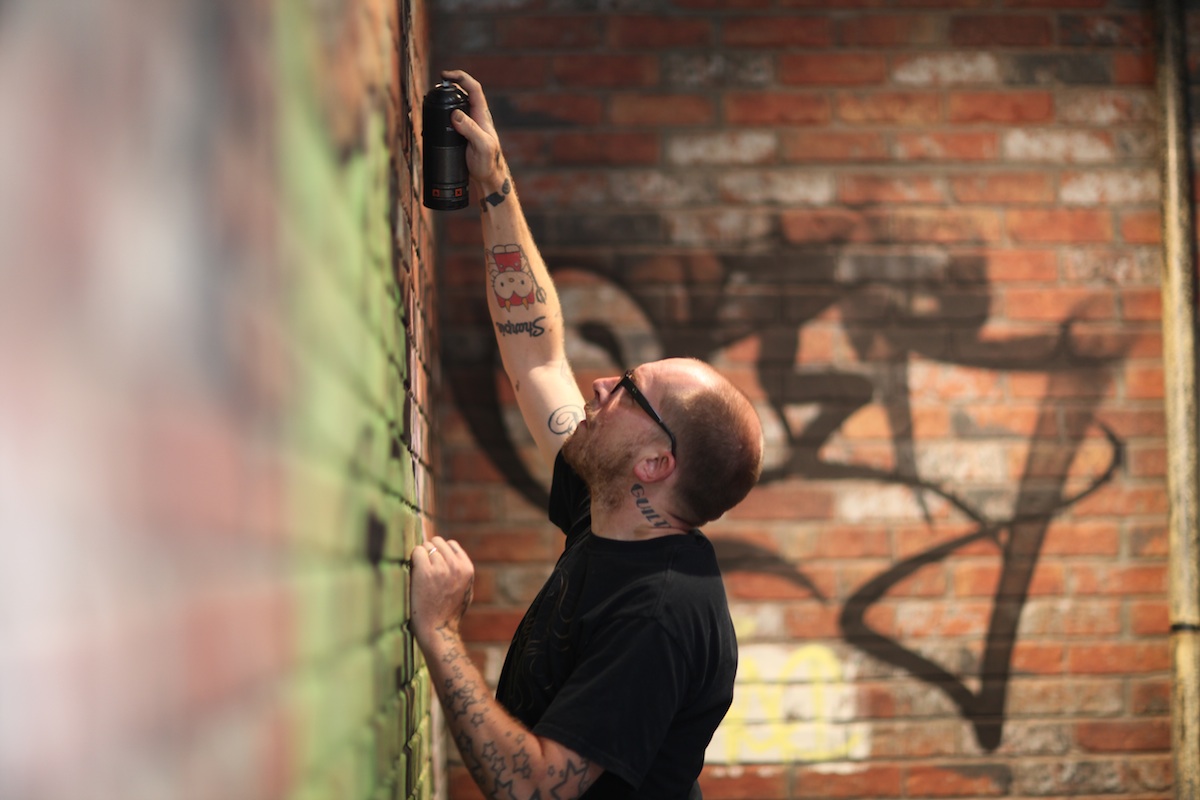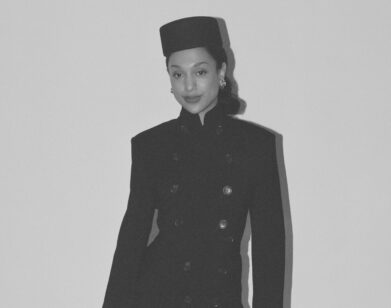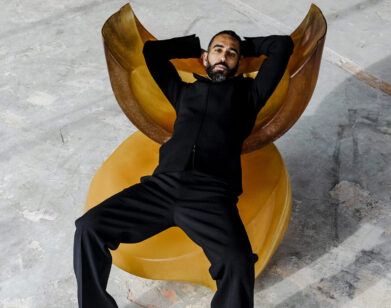Ben Eine’s Age of Innocence

ABOVE: BEN EINE AT WORK. IMAGE COURTESY OF IAN COX
Sometime in the late ’90s, London-born artist Ben “Eine” Flynn began edging away from his roots, scrawling his name up and down the Tube lines. After two decades building a reputation as one of Britain’s most notorious graffiti louts, he began painting words besides his own moniker. Giant hyper-colored assertions like “VANDAL” replaced his omnipresent tags and stickers, and by 2011, he’d painted an entire road near Spitalfields shutter-to-shutter with all 26 letters of the alphabet, effectively turning Middlesex Street into a vandalized episode of Sesame Street.
A former principal screenprinter at seminal British street art institution Pictures On Walls, Eine spent the 2000s pulling screens for everyone from close friend Banksy to David Shrigley before going out solo. Now he has several exhibitions under his paint-splattered belt, a canvas miraculously hanging in the White House, and his candy-hued statements seen from here to Stockholm.
Although Eine has a show opening this weekend at Corey Helford Gallery’s new space in Los Angeles, it’s not the only thing on his mind. We caught Eine in a brief moment of rest between prepping for his first solo gig in two years and—believe it or not—his wedding the very next day.
GEORGIA FRANCES KING: Wait, let me get this straight: you’re getting married the day after your show opens on Saturday? Are you crazy?
BEN EINE: Oh dude, it’s been a fucking nightmare. Not only has it been my first solo exhibition since 2011 and the wedding, but I’ve also been dealing with attorneys and filing out forms and marriage certificates and birth certificates and passports. The only thing we’re not doing is moving house—we left that out of the equation. [laughs] As soon as the show’s over on Saturday night, I can start worrying about the wedding on Sunday. That way, I’ve only got a day to worry about it.
KING: Lest I give you an anxiety attack, let’s focus on your new exhibition. By all accounts, it follows a different direction to what we’re used to from you. Can you talk us through it?
EINE: I’ve been working with Corey Helford Gallery for two or three years, and I don’t know why, but I’ve always given them something different: not my typical typography stuff. This show is full of old images of innocent children from ’40s and ’50s coloring-in books juxtaposed with video cameras, warning dogs, CCTV surveillance, and razor wire. I’ve painted the canvases with intricate patterns and then spray-painted over them, washed the spray paint off, and then screenprinted over them again. It’s playing around with this idea of a tag being cleaned off but you can still kind of see it underneath, and then someone else puts another layer on top of that. It’s fucking around with the layers, really.
KING: How do you feel these layers have been building up within the movement these past few years?
EINE: When we did the MOCA show two years ago [Art On The Streets, the largest public museum assertion recognizing graffiti and street art to date], there were people there that were heroes of mine, but nearly everyone in the show had been arrested. Hardly any of us went to college to study art, and now this fucking cool museum in L.A. was showing our work. None of us could have imagined we would’ve been celebrated artists. We all were just into graffiti and wanted to push the art form forward. Looking back, it helped that we were so young, because if we were striving to become artists, then it would’ve affected the work we did. A lot of our styles were created by the innocence we had. So these paintings in my show are about those layers of graffiti and the street and the interesting patterns they create.
KING: Where do typography and art meet?
EINE: It’s interesting. I haven’t studied art and I haven’t studied typography, but I’ve still gone out and done it. A good friend of mine is a typographer and a graphic designer. He bought one of my A-to-Z paintings a few years ago, and said he sees so many things wrong in the painting in a typographic sense. But yet it works. The things he was taught at college, I don’t do, but it still works. And if he tried to do what I do the way he was taught, he didn’t think it would work. So that says something about art school. One of the advantages of not going to art school is that you’re not taught what you can’t do. When I was screenprinting at Pictures On Walls, I hadn’t been taught screenprinting—I just worked out how to do it. So I’d be talking to an artist about what they wanted to do, and they’d say, “Yeah, I want to put some bleach on top of that.” And if I was a trained screenprinter, I would’ve be like, “You can’t put bleach in a screen, it’ll fuck everything up.” But because I didn’t know anything, I was like, “Fuck it! Yeah let’s try it!” We did some interesting and fucking cool things because we didn’t know we couldn’t do them.
KING: How did you come to be at Pictures On Walls—one of the world’s most infamous screenprinting studios—with zilch experience?
EINE: When I started working at Pictures On Walls, I’d been hanging out with Banksy for a few years travelling around the world together painting stuff, and then we moved into a new office and wanted to do screenprinting. But we didn’t know how to do it at the time. So I was like, “Yeah dude, I’ll do it.” And at the beginning, it was fun because I was doing something new and working with cool artists. But the excitement went out of it, and it felt like I was a screenprinting machine for other artists. I was spending all of my time making other people’s art, and eventually I was like, “I want to make my own art.”
KING: When you think about it, letters are just symbols made up of color and contour. We assign meaning to them later because that’s what we’ve been taught to do, but out of context, they’re pretty much just abstract lines and shapes. How does context affect your word work?
EINE: I painted the words “GREAT ADVENTURE” in Beijing, Dallas, San Francisco, Copenhagen, and Japan, and everybody came up to me and said something different like, “Great adventure! It means this-or-that to me! My kids love it! My granny loves it!” And I got that line from a Biggie Smalls song! So what it means to me is completely different to everybody else. And that’s what I love about random words and phrases taken out of context: everyone applies their own context. If you want to apply something political or meaningful to a word I wrote on the side of the wall, then it’s up to you.
KING: Even when you take meaning out of them, letterforms themselves are pretty beautiful. And that’s one of the underlying aspects of graffiti: making words look as aesthetically pleasing as possible, right?
EINE: It is! Old typography or letter woodblocks that are hand-carved, cracked, and worn are especially beautiful. I love that aged, handmade effect, and that’s why I don’t muck around much with Photoshop. I’d much rather draw something, scan it in, print it out, and put that together as my stencil. I love the process of cutting everything out with a scalpel yourself: I don’t want to have my stencils drawn up in Illustrator, then laser-cut. I like the fact that it’s slightly wrong; I think it gives it a beauty. The individual and handmade will always be worth more than what a computer can do, at least until computers can learn how to make mistakes!
KING: How have you seen the graffiti scene evolve over the years?
EINE: I love the way that graffiti has changed because of the way the police have policed it. We used to tag the inside of trains with marker pens, and then they worked out a way to clean them off really easily. So then we started painting using leather dye to make it harder for them to clean off, and then they worked out how to wash that off too. So then we started scratching into the windows! Graffiti writers will never stop. They’ll just evolve. It’s interesting what ideas people come up with and how it all extends forward. The police never solve the problem, they just make it worse. We were young once so could run away from the cops and not get caught. And nowadays the cops are younger than us! But now we’re older now and make money, so fuck it: if it’s too hard to paint in London, we’ll just go to Mexico City and paint there. [laughs]
KING: From train scratchies to getting a call from 10 Downing Street in 2010 saying Prime Minister David Cameron wanted to gift Barack Obama with one of your pieces when he headed over to America for the first time—how the hell did that come about?
EINE: I think it was through his wife, Samantha. I did this collaboration with Anya Hindmarch who is a posh handbag designer from London, and Samantha is best friends with her. So I’m guessing she would have seen the tote bags and shown David.
KING: Where were you when you got the call?
EINE: I was in my studio cutting out some stencils! I got a phone call saying, “Do you mind if I give your number to 10 Downing Street? David Cameron’s looking to give a piece of art to the most important man in the world.” And then 10 minutes later, someone from 10 Downing called up and told me they needed a piece of artwork by Monday… and this was Friday night at 10 pm. So it was two days of frantically painting canvases, and one of the paintings I already had available said “Twenty First Century City” on it, and they loved it. Then it was four days of everything being fucking crazy when the media found out. CNN sent a car down to my studio in Hastings, drove me back up to their studio in London for a 20-second live pick-up to Atlanta, and then drove me back. That’s an hour and a half drive each way!
KING: This whole journey from hoodlum to internationally acclaimed artist must be a headspin for your mum.
EINE: My mum is now incredibly proud and thinks it’s incredibly lucky I’ve turned out how I did. I remember one time when I was young, my mum went down to visit a friend of hers and came back nearly in tears saying, “Why is it that everywhere I go I have to see your tags?!” Police would be knocking at my door at 4 o’clock in the morning with me in handcuffs, and if my mum found paint in my room she’d chuck it away. She hated it. She absolutely hated it. But now she understands that if it wasn’t because of all that, then I wouldn’t be where I am now with a painting in the White House and a visit to 10 Downing Street. I turned it into a job.
KING: Before all of this happened, you worked at an insurance firm by day for 20 years—what did you learn there that you’ve applied to life on the streets?
EINE: I learned not to look like a graffiti writer when you’re tagging the inside of trains. [laughs] You’re far better off in a suit and tie, tagging the train, then sitting down and reading the newspaper. No one’s ever going to think you did it! When I quit the firm, I got my whole arm tattooed with stars, then I got two extra ones put on my hand and shortly after got another tattoo on my neck. The idea of them being so visible was so I couldn’t go back and get another job in the insurance world. I wanted to do something creative. I had ideas. And I didn’t want to sit at a desk. I spent 20 years tagging my name over fucking everything and destroying shit, and in some way, I’m now making streets and public spaces look better and more enjoyable. I like giving people the idea they can go out and create something.
BEN EINE’S LATEST SOLO EXHIBITION, INNOCENCE, OPENS ON SATURDAY NIGHT AT CGH CIRCA, COREY HELFORD GALLERY’S NEW SPACE IN CULVER CITY, LOS ANGELES. MORE DETAILS AT COREY HELFORD GALLERY OR ON EINE’S WEBSITE.






